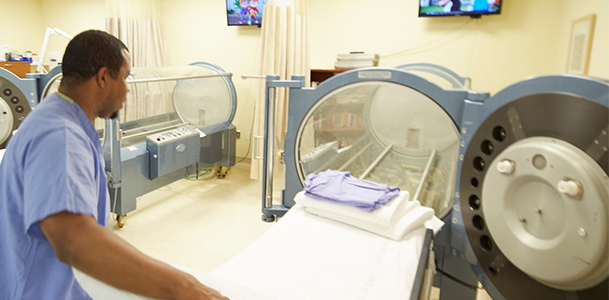Hyperbaric Oxygen Therapy
Hyperbaric oxygen therapy (HBOT) provides high-pressure oxygen in a pressurized cylinder, called a hyperbaric chamber. Breathing 100 percent pure oxygen increases the amount of oxygen in the blood to many times its normal level. Blood vessels deliver this "super" oxygenated blood to tissues throughout the body to help heal, fight off infection, decrease swelling and aid in the growth of new blood vessels. These benefits cannot be achieved by breathing oxygen in a regular room.
Conditions Treated with Hyperbaric Oxygen (HBO) Therapy
HBOT was first used primarily to treat divers who had decompression sickness, also known as "the bends." Today, it is used also to treat carbon monoxide poisoning and as part of treatment for a number of medical and surgical conditions. For example, HBOT therapy can play an important role in the treatment of chronic wounds, and may be part of a treatment plan that includes surgically removing dead tissue from a wound, taking antibiotics, undergoing physical therapy and managing diet. Patients with the following conditions may benefit from HBOT:
- Some non-healing diabetic wounds
- Radiation necrosis (radiation damage from cancer treatments)
- Necrotizing infections
- Decompression illness (the "bends")
- Carbon monoxide poisoning
- Air embolism
- Reconstructive surgery
- Gas gangrene
- Crush injuries
- Chronic refractory osteomyelitis (bone infections)
GW Hospital Hyperbaric Medicine
The hyperbaric medicine staff at the George Washington University Hospital's Wound Care and Limb Preservation Center is a specialized team of skilled emergency physicians, nurses and technicians. Before starting your hyperbaric therapy, a physician and technician will meet with you to discuss your overall treatment plan and address any questions or concerns you may have.
HBOT lasts for about one and a half hours, although your stay at the Wound Care and Limb Preservation Center may be longer. The hyperbaric physician and your referring physician will determine the best treatment schedule for you. Most wound-healing plans require 30 to 40 HBOT sessions. Treatment can be performed on either an inpatient or outpatient basis, but the greatest benefit is attained when therapy is given five days per week over an extended period of time.
How to Prepare for Treatment
- Do not drink alcohol for eight hours before treatment
- Always eat a balanced, full meal before treatment, especially if you are diabetic
- Absolutely nothing can be taken into the chamber, including hard contact lenses and hearing aids
- Valuables are best left at home or given to your technician to lock away
- Smoking and the use of tobacco are strongly discouraged because it may prevent you from fully benefiting from the treatment
- Use the restroom prior to treatment to avoid interruption of therapy. A bedpan or urinal can be provided, if needed.
Your Treatment Experience
The spacious, advanced facility is designed to provide a comfortable, pleasant environment for patients. We use hyperbaric chambers that are spacious enough so a patient can comfortably lie down during treatment.
There is always a technician to take care of you during your stay at the Wound Care and Limb Preservation Center. Transparent, double-acrylic chamber walls allow technicians to closely monitor patients, as well as provide patients with a clear outward view. While inside these total-body chambers, patients can communicate with attending technicians via intercom, drink, watch television, listen to music or nap.
Once you enter the hyperbaric chamber, you may notice that the chamber is noisy. The temperature inside the chamber will begin to rise as the air begins to circulate. This is temporary and will be adjusted to a comfortable level once the correct pressure is obtained, which will take about 10 minutes.
You also may feel fullness in your ears and they may crackle or pop while the chamber is being pressurized. This is similar to the sensations you feel when you are flying and it is normal. Let us know if your ears hurt during treatment and we will adjust the air pressure to make your experience in the chamber as comfortable as possible. You will need to clear your ears often by:
- Sipping water and/or swallowing
- Yawning
- Pinching your nose and blowing.
Temporary Side Effects
Side effects rarely occur with HBOT, but some patients develop temporary changes in eyesight after several weeks of treatment. They may become nearsighted and need to adjust their eyeglass prescriptions. If your prescription changes during treatment, do not discard your old corrective lenses, as your eyesight will return to normal a few months after treatment.
There is an extremely rare chance that oxygen therapy will cause nausea or seizures. These side effects stop immediately when oxygen is replaced by air and cause no permanent problems. It almost never occurs in patients, except for those with high fevers; therefore we will take your temperature each day before treatment.

